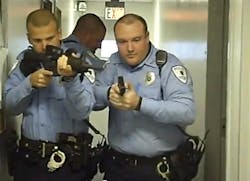Threats evolve. So do we. I was hosting a speaker call this morning with a few people that represented different walks of life: Security consultant, police officer, SWAT team member, trauma surgeon, school training expert. We were discussing an upcoming training program about active shooters in school environments (register here for this September 27th webinar). There were two interesting issues that came up as part of the discussion: first, the mutable methodology of active shooters, and second, the “what-if” games you can play to adapt suggested responses for incidents.
The reality is that every active shooter incident has special attributes. Think about the different tactics that shooters have used. In Jonesboro, a fire alarm was pulled and the gunman shot students as they exited the building. At Virginia Tech, the shooter barricaded the doors to keep law enforcement out so his spree could continue. At the Aurora, Colo., movie theater, the shooter released cans of pepper spray.
My point here is that active shooter incidents evolve, and response methodologies evolve too. Police no longer sit and wait for SWAT to arrive to penetrate the situation. The lesson for security managers is the same; you have to review your operations plans following every major incident that could be replicated. What did you learn from that incident? Should your response plan change to accommodate different modalities of the threat?
Second, there’s a “what-if” game we can play with every suggested response model. The City of Houston and the Department of Homeland Security recently released a video titled “Run, Hide, Fight: How to survive an active shooter event.” You can watch the full video on SecurityInfoWatch.com. What’s interesting is that the Run, Hide, Fight training is contrary to what is called A.L.I.C.E. training, which stands for Alert, Lockdown, Inform, Counter, Evacuate (watch training video). One concept wants people evacuating instantly. The other puts evacuation as the last option. Our speakers debated whether you can generally apply these recommendations in a specific situation, or whether they are too general to do much with.
Let’s play some “what-ifs.” If you put a school on active shooter warning, what should you do with students outside? Do they come back in the school? Do they escape into the neighborhood? Where is the threat? Do you even know – is it a gunman in the area/neighborhood or in the school? Here’s another “what-if”: Do you even suggest that young students try to “Counter” the gunman by fighting? Is an elementary student too young to be trained to “counter?” How about a middle school student? A high school student? A college student? How about considering this “what-if”: If you are in lockdown and are sheltering inside a room (common training for school shootings or those in a workplace), what do you do if the fire alarm is pulled? Do you stay sheltered or do you evacuate?
Our speakers know that you can “what-if” a situation into oblivion until you are paralyzed with inaction. There’s a lesson in that, and I think it’s why the Houston video keeps it simple, and focuses on “Run, Hide, and Fight.” It encourages persons to take their lives into their own hands. But even that concept is not so simple when you’re talking about school-age children. The lesson here is that no matter which direction you go (having adults take initiative to escape, or having young students trained to shelter in place), you need to have conversations with the people you are trying to protect (your workers, your staff, your students, whoever they may be) to make sure everyone understands their role and response. On that note, it’s positive to see that some states now require schools practice active shooter drills. Even if you’re protecting a business, not a campus, I’d encourage you to voluntarily consider offering similar training to those you protect.
About the Author

Geoff Kohl
Editorial Director/Editor-in-Chief/Associate Publisher
Geoff Kohl is the Marketing Director for the Security Industry Association (SIA). He is the former Editor-in-Chief of SecurityInfoWatch.com
